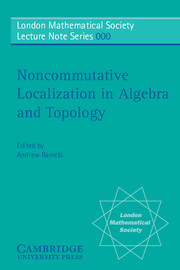Book contents
- Frontmatter
- Contents
- Dedication
- Preface
- Historical Perspective
- Conference Participants
- Conference Photo
- Conference Timetable
- On flatness and the Ore condition
- Localization in general rings, a historical survey
- Noncommutative localization in homotopy theory
- Noncommutative localization in group rings
- A non-commutative generalisation of Thomason's localisation theorem
- Noncommutative localization in topology
- L2-Betti numbers, Isomorphism Conjectures and Noncommutative Localization
- Invariants of boundary link cobordism II. The Blanchfield-Duval form
- Noncommutative localization in noncommutative geometry
- Index
Noncommutative localization in homotopy theory
Published online by Cambridge University Press: 19 October 2009
- Frontmatter
- Contents
- Dedication
- Preface
- Historical Perspective
- Conference Participants
- Conference Photo
- Conference Timetable
- On flatness and the Ore condition
- Localization in general rings, a historical survey
- Noncommutative localization in homotopy theory
- Noncommutative localization in group rings
- A non-commutative generalisation of Thomason's localisation theorem
- Noncommutative localization in topology
- L2-Betti numbers, Isomorphism Conjectures and Noncommutative Localization
- Invariants of boundary link cobordism II. The Blanchfield-Duval form
- Noncommutative localization in noncommutative geometry
- Index
Summary
Introduction
In a sense, noncommutative localization is at the center of homotopy theory, or even more accurately, one form of it is homotopy theory. After all, Gabriel and Zisman and later Quillen observed that the homotopy category of CW-complexes can be obtained from the category of topological spaces by formally inverting the maps which are weak homotopy equivalences. More generally, the homotopy category of any Quillen model category can be built by formally inverting maps. In a slightly different direction, the process of localization with respect to a map (§2) has recently developed into a powerful tool for making homotopy-theoretic constructions; roughly speaking, localizing with respect to f involves converting an object X into a new one, Lf(X), with the property that, as far as mapping into Lf(X) goes, f looks like an equivalence.
In this paper we will show how the Cohn noncommutative localization described in can be interpreted as an instance of localization with respect to a map (3.2). Actually, we produce a derived form of the Cohn localization, and show that the circumstances in which the Cohn localization is most useful are exactly those in which the higher derived information vanishes (3.3). Finally, we sketch how the derived Cohn localization can sometimes be computed by using a derived form of the categorical localization construction from Gabriel and Zisman (§4).
Information
- Type
- Chapter
- Information
- Noncommutative Localization in Algebra and Topology , pp. 24 - 39Publisher: Cambridge University PressPrint publication year: 2006
Accessibility standard: Unknown
Why this information is here
This section outlines the accessibility features of this content - including support for screen readers, full keyboard navigation and high-contrast display options. This may not be relevant for you.Accessibility Information
- 4
- Cited by
